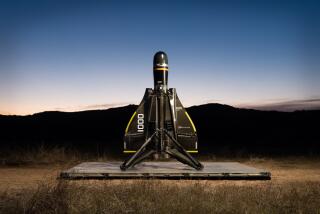Army Takes Aim at Replacing M-16 Rifle
FT. BENNING, Ga. â The Army is searching for an automatic rifle to replace the M-16, which soldiers have used since the Vietnam War.
The goal is to develop a weapon that will make the 21st-Century soldier twice as effective at wounding or killing enemy troops, overcoming battlefield stress and unpredictable targets.
âThe M-16A2 is the finest combat rifle in the world, but the accuracy of that weapon, because of human factors, is not as high as one would like it to be,â said Pete Rowland, public affairs officer for the Armyâs Armament Research, Development and Engineering Center at Picatinny Arsenal, N.J.
Since September, 36 Army and Air Force shooters have been conducting preliminary tests with four advanced combat rifle prototypes at Ft. Benning.
The Army has spent about $40 million since 1982 on research and development and expects to spend another $17 million by 1991, when officials decide what technology to pursue.
The prototypes were submitted by Colt Industries of Hartford, Conn., Steyr-Daimler-Puch of Steyr, Austria, AAI Corp. of Hunt Valley, Md., and Heckler & Koch, a German firm with a U.S. subsidiary in Chantilly, Va.
The Colt rifle fires conventional ammunition or a duplex cartridge with two projectiles. Colt claims one projectile travels to the point of aim and the other diverges slightly to increase hit probability.
The Steyr uses a plastic-cased cartridge that fires a steel flechette, or dart. The AAI rifle fires a brass cartridge with a flechette and the Heckler & Koch a bullet from a âcaseless cartridgeâ made of molded propellant.
Rowland said that the Army is trying to develop a rifle that fires lightweight, low-cost ammunition.
âThe soldier of today . . . is weightily equipped,â he said. âAnything that can be done to make that lighter--and a lot is being done--will increase his effectiveness. Probably from head to foot, the Army is looking for a way to lighten the load.â
The M-16 already is lighter than the Soviet-designed AK-47, but that assault rifle has the reputation of being more durable on the dirty battlefield than the M-16. The M-16 typically takes smaller ammunition than the AK and most other assault rifles.
In battle, the soldierâs shooting skills are hampered by a variety of factors, such as stress, fatigue, weather conditions and obscured targets, Rowland said.
âThe goal is to develop some compensations in the weapon to offset the outside factors that affect a soldier in battle,â he added. âThe soldier . . . has to have twice the accuracy that he has with the current version.â
Earlier this year, the Army conducted extensive engineering and safety tests on the prototypes at Aberdeen Proving Ground, Md.
The Army scheduled a media briefing and demonstration of the weapons this month at Ft. Benning. Next month, another team of Army and Air Force shooters will arrive at Ft. Benning to start another three months of testing.
Bill Harris, a media relations specialist at Picatinny Arsenal, said there is no timetable for phasing out the M-16.
âSince the M-16 is over 20 years old now, the Defense Department has decided to look at new technology,â he said. âThe average life of a military rifle is 20 to 30 years, going back to the flintlocks used in the Revolutionary War. If we find a technology that meets the needs of doubling the effectiveness of the M-16, then . . . we could have a new weapon in the hands of troops as early as 1995.â
The M-16 was first issued to U.S. troops in 1967. During the Vietnam War it was criticized for jamming. The problem was corrected by using a different type of gunpowder in the rifleâs 5.56-mm ammunition. The latest version, known as the M-16A2, was introduced in 1987. It has a maximum effective range of 550 meters and is more accurate and reliable than the earlier versions, Harris said.
âThe M-16 is a very reliable weapon,â he added. âItâs considered one of the best combat rifles in the world.â
More to Read
Sign up for Essential California
The most important California stories and recommendations in your inbox every morning.
You may occasionally receive promotional content from the Los Angeles Times.








